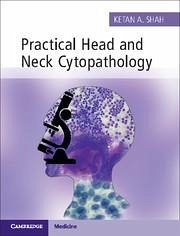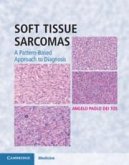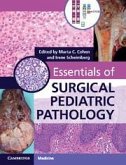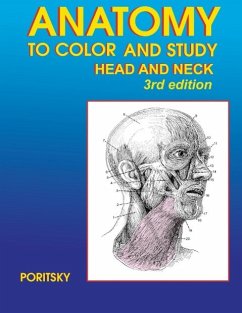Ketan A Shah
Practical Head and Neck Cytopathology with Online Static Resource
Schade – dieser Artikel ist leider ausverkauft. Sobald wir wissen, ob und wann der Artikel wieder verfügbar ist, informieren wir Sie an dieser Stelle.
Ketan A Shah
Practical Head and Neck Cytopathology with Online Static Resource
- Broschiertes Buch
- Merkliste
- Auf die Merkliste
- Bewerten Bewerten
- Teilen
- Produkt teilen
- Produkterinnerung
- Produkterinnerung
This beautifully illustrated bench book provides an easy-to-follow, stepwise approach to the cytologic diagnosis of head and neck lesions.
Andere Kunden interessierten sich auch für
![Pearls and Pitfalls in Head and Neck Pathology with Online Resource Pearls and Pitfalls in Head and Neck Pathology with Online Resource]() Pearls and Pitfalls in Head and Neck Pathology with Online Resource130,99 €
Pearls and Pitfalls in Head and Neck Pathology with Online Resource130,99 €![Non-Neoplastic Pulmonary Pathology with Online Resource Non-Neoplastic Pulmonary Pathology with Online Resource]() Sanjay MukhopadhyayNon-Neoplastic Pulmonary Pathology with Online Resource235,99 €
Sanjay MukhopadhyayNon-Neoplastic Pulmonary Pathology with Online Resource235,99 €![Transplantation Pathology Hardback with Online Resource Transplantation Pathology Hardback with Online Resource]() Transplantation Pathology Hardback with Online Resource239,99 €
Transplantation Pathology Hardback with Online Resource239,99 €![Head and Neck Head and Neck]() Margaret Brandwein-GenslerHead and Neck184,99 €
Margaret Brandwein-GenslerHead and Neck184,99 €![Soft Tissue Sarcomas Hardback with Online Resource Soft Tissue Sarcomas Hardback with Online Resource]() Angelo Paolo Dei TosSoft Tissue Sarcomas Hardback with Online Resource221,99 €
Angelo Paolo Dei TosSoft Tissue Sarcomas Hardback with Online Resource221,99 €![Essentials of Surgical Pediatric Pathology with DVD-ROM Essentials of Surgical Pediatric Pathology with DVD-ROM]() Essentials of Surgical Pediatric Pathology with DVD-ROM223,99 €
Essentials of Surgical Pediatric Pathology with DVD-ROM223,99 €![Anatomy to Color and Study Head and Neck 3rd edition Anatomy to Color and Study Head and Neck 3rd edition]() Ray PoritskyAnatomy to Color and Study Head and Neck 3rd edition37,99 €
Ray PoritskyAnatomy to Color and Study Head and Neck 3rd edition37,99 €-
-
This beautifully illustrated bench book provides an easy-to-follow, stepwise approach to the cytologic diagnosis of head and neck lesions.
Produktdetails
- Produktdetails
- Verlag: Cambridge University Press
- Seitenzahl: 240
- Erscheinungstermin: 23. März 2015
- Englisch
- Abmessung: 246mm x 188mm x 20mm
- Gewicht: 975g
- ISBN-13: 9781107443235
- ISBN-10: 1107443237
- Artikelnr.: 41609094
- Herstellerkennzeichnung
- Libri GmbH
- Europaallee 1
- 36244 Bad Hersfeld
- gpsr@libri.de
- Verlag: Cambridge University Press
- Seitenzahl: 240
- Erscheinungstermin: 23. März 2015
- Englisch
- Abmessung: 246mm x 188mm x 20mm
- Gewicht: 975g
- ISBN-13: 9781107443235
- ISBN-10: 1107443237
- Artikelnr.: 41609094
- Herstellerkennzeichnung
- Libri GmbH
- Europaallee 1
- 36244 Bad Hersfeld
- gpsr@libri.de
Ketan A. Shah is Consultant Pathologist, John Radcliffe Hospital, Oxford University Hospitals NHS Trust, Oxford, UK.
Preface
Acknowledgement
1. Aspiration technique and stains
2. Lymph nodes
2.1. Introduction
2.2. Reactive lymph node hyperplasia
2.3. Granulomatous inflammation
2.4. Lymphoma
2.5. Metastatic disease
2.6. Miscellaneous lymph node conditions
2.7. Approach to lymph node cytology
3. Salivary glands
3.1. Introduction and cytology of normal salivary glands
3.2. Proposed reporting system of salivary gland aspirates
3.3. Inflammatory salivary gland lesions
3.4. Cystic salivary gland lesions
3.5. Benign salivary gland neoplasms
3.6. Basal cell neoplasms
3.7. Oncocytic lesions
3.8. Malignant salivary gland neoplasms
3.9. Approach to salivary gland cytology
3.10. Role of repeat FNA
4. Thyroid
4.1. Introduction
4.2. Colloid goiter
4.3. Thyroiditis
4.4. Papillary carcinoma
4.5. Follicular neoplasms
4.6. Medullary carcinoma
4.7. Poorly differentiated carcinoma
4.8. Undifferentiated (anaplastic) carcinoma
4.9. Hyalinizing trabecular tumour
4.10. Lymphoma
4.11. Approach to thyroid cytology
5. Cystic neck lesions
5.1. Introduction
5.2. Branchial cyst
5.3. Thyroglossal cyst
5.4. Lymphangioma
5.5. Seroma and lymphocele
6. Other neck lesions
6.1. Introduction
6.2. Abscess
6.3. Cervicofacial actinomycosis
6.4. Parathyroid lesions
6.5. Suture granuloma
6.6. Lipoma
6.7. Spindle cell lipoma
6.8. Nodular fasciitis
6.9. Paraganglioma
6.10. Pilomatricoma
6.11. Schwannoma
Index.
Acknowledgement
1. Aspiration technique and stains
2. Lymph nodes
2.1. Introduction
2.2. Reactive lymph node hyperplasia
2.3. Granulomatous inflammation
2.4. Lymphoma
2.5. Metastatic disease
2.6. Miscellaneous lymph node conditions
2.7. Approach to lymph node cytology
3. Salivary glands
3.1. Introduction and cytology of normal salivary glands
3.2. Proposed reporting system of salivary gland aspirates
3.3. Inflammatory salivary gland lesions
3.4. Cystic salivary gland lesions
3.5. Benign salivary gland neoplasms
3.6. Basal cell neoplasms
3.7. Oncocytic lesions
3.8. Malignant salivary gland neoplasms
3.9. Approach to salivary gland cytology
3.10. Role of repeat FNA
4. Thyroid
4.1. Introduction
4.2. Colloid goiter
4.3. Thyroiditis
4.4. Papillary carcinoma
4.5. Follicular neoplasms
4.6. Medullary carcinoma
4.7. Poorly differentiated carcinoma
4.8. Undifferentiated (anaplastic) carcinoma
4.9. Hyalinizing trabecular tumour
4.10. Lymphoma
4.11. Approach to thyroid cytology
5. Cystic neck lesions
5.1. Introduction
5.2. Branchial cyst
5.3. Thyroglossal cyst
5.4. Lymphangioma
5.5. Seroma and lymphocele
6. Other neck lesions
6.1. Introduction
6.2. Abscess
6.3. Cervicofacial actinomycosis
6.4. Parathyroid lesions
6.5. Suture granuloma
6.6. Lipoma
6.7. Spindle cell lipoma
6.8. Nodular fasciitis
6.9. Paraganglioma
6.10. Pilomatricoma
6.11. Schwannoma
Index.
Preface
Acknowledgement
1. Aspiration technique and stains
2. Lymph nodes
2.1. Introduction
2.2. Reactive lymph node hyperplasia
2.3. Granulomatous inflammation
2.4. Lymphoma
2.5. Metastatic disease
2.6. Miscellaneous lymph node conditions
2.7. Approach to lymph node cytology
3. Salivary glands
3.1. Introduction and cytology of normal salivary glands
3.2. Proposed reporting system of salivary gland aspirates
3.3. Inflammatory salivary gland lesions
3.4. Cystic salivary gland lesions
3.5. Benign salivary gland neoplasms
3.6. Basal cell neoplasms
3.7. Oncocytic lesions
3.8. Malignant salivary gland neoplasms
3.9. Approach to salivary gland cytology
3.10. Role of repeat FNA
4. Thyroid
4.1. Introduction
4.2. Colloid goiter
4.3. Thyroiditis
4.4. Papillary carcinoma
4.5. Follicular neoplasms
4.6. Medullary carcinoma
4.7. Poorly differentiated carcinoma
4.8. Undifferentiated (anaplastic) carcinoma
4.9. Hyalinizing trabecular tumour
4.10. Lymphoma
4.11. Approach to thyroid cytology
5. Cystic neck lesions
5.1. Introduction
5.2. Branchial cyst
5.3. Thyroglossal cyst
5.4. Lymphangioma
5.5. Seroma and lymphocele
6. Other neck lesions
6.1. Introduction
6.2. Abscess
6.3. Cervicofacial actinomycosis
6.4. Parathyroid lesions
6.5. Suture granuloma
6.6. Lipoma
6.7. Spindle cell lipoma
6.8. Nodular fasciitis
6.9. Paraganglioma
6.10. Pilomatricoma
6.11. Schwannoma
Index.
Acknowledgement
1. Aspiration technique and stains
2. Lymph nodes
2.1. Introduction
2.2. Reactive lymph node hyperplasia
2.3. Granulomatous inflammation
2.4. Lymphoma
2.5. Metastatic disease
2.6. Miscellaneous lymph node conditions
2.7. Approach to lymph node cytology
3. Salivary glands
3.1. Introduction and cytology of normal salivary glands
3.2. Proposed reporting system of salivary gland aspirates
3.3. Inflammatory salivary gland lesions
3.4. Cystic salivary gland lesions
3.5. Benign salivary gland neoplasms
3.6. Basal cell neoplasms
3.7. Oncocytic lesions
3.8. Malignant salivary gland neoplasms
3.9. Approach to salivary gland cytology
3.10. Role of repeat FNA
4. Thyroid
4.1. Introduction
4.2. Colloid goiter
4.3. Thyroiditis
4.4. Papillary carcinoma
4.5. Follicular neoplasms
4.6. Medullary carcinoma
4.7. Poorly differentiated carcinoma
4.8. Undifferentiated (anaplastic) carcinoma
4.9. Hyalinizing trabecular tumour
4.10. Lymphoma
4.11. Approach to thyroid cytology
5. Cystic neck lesions
5.1. Introduction
5.2. Branchial cyst
5.3. Thyroglossal cyst
5.4. Lymphangioma
5.5. Seroma and lymphocele
6. Other neck lesions
6.1. Introduction
6.2. Abscess
6.3. Cervicofacial actinomycosis
6.4. Parathyroid lesions
6.5. Suture granuloma
6.6. Lipoma
6.7. Spindle cell lipoma
6.8. Nodular fasciitis
6.9. Paraganglioma
6.10. Pilomatricoma
6.11. Schwannoma
Index.








